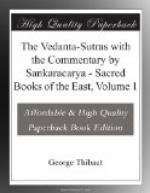To this reasoning we make the following reply.—It is impossible to base the assertion that the pradhana, &c. have Scripture in their favour on the reference to their number which you pretend to find in the text, ’on account of the diversity of the Sa@nkhya categories.’ The Sa@nkhya categories have each their individual difference, and there are no attributes belonging in common to each pentad on account of which the number twenty-five could be divided into five times five. For a number of individually separate things can, in general, not be combined into smaller groups of two or three, &c. unless there be a special reason for such combination.—Here the Sa@nkhya will perhaps rejoin that the expression five (times) five is used only to denote the number twenty-five which has five pentads for its constituent parts; just as the poem says, ‘five years and seven Indra did not rain,’ meaning only that there was no rain for twelve years.—But this explanation also is not tenable. In the first place, it is liable to the objection that it has recourse to indirect indication.[235] In the second place, the second ‘five’ constitutes a compound with the word ‘people,’ the Brahma/n/a-accent showing that the two form one word only.[236] To the same conclusion we are led by another passage also (Taitt. Sa/m/h. I, 6, 2, 2, pa/nk/ana/m/ tva pa/nk/ajananam, &c.) where the two terms constitute one word, have one accent and one case-termination. The word thus being a compound there is neither a repetition of the word ‘five,’ involving two pentads, nor does the one five qualify the other, as the mere secondary member of a compound cannot be qualified by another word.—But as the people are already denoted to be five by the compound ‘five-people,’ the effect of the other ‘five’ qualifying the compound will be that we understand twenty-five people to be meant; just as the expression ‘five five-bundles’ (pa/nk/a pa/nk/apulya/h/) conveys the idea of twenty-five bundles.—The instance is not an analogous one, we reply. The word ‘pa/nk/apuli’ denotes a unity (i.e. one bundle made up of five bundles) and hence when the question arises, ’How many such bundles are there?’ it can be qualified by the word ‘five,’ indicating that there are five such bundles. The word pa/nk/ajana/h/, on the other hand, conveys at once the idea of distinction (i.e. of five distinct things), so that there is no room at all for a further desire to know how many people there are, and hence no room for a further qualification. And if the word ‘five’ be taken as a qualifying word it can only qualify the numeral five (in five-people); the objection against which assumption has already been stated.—For all these reasons the expression the five five-people cannot denote the twenty-five categories of the Sa@nkhyas.—This is further not possible ’on account of the excess.’ For on the Sa@nkhya interpretation there would be an excess over the number twenty-five, owing to the circumstance of the ether and the Self being mentioned separately.




